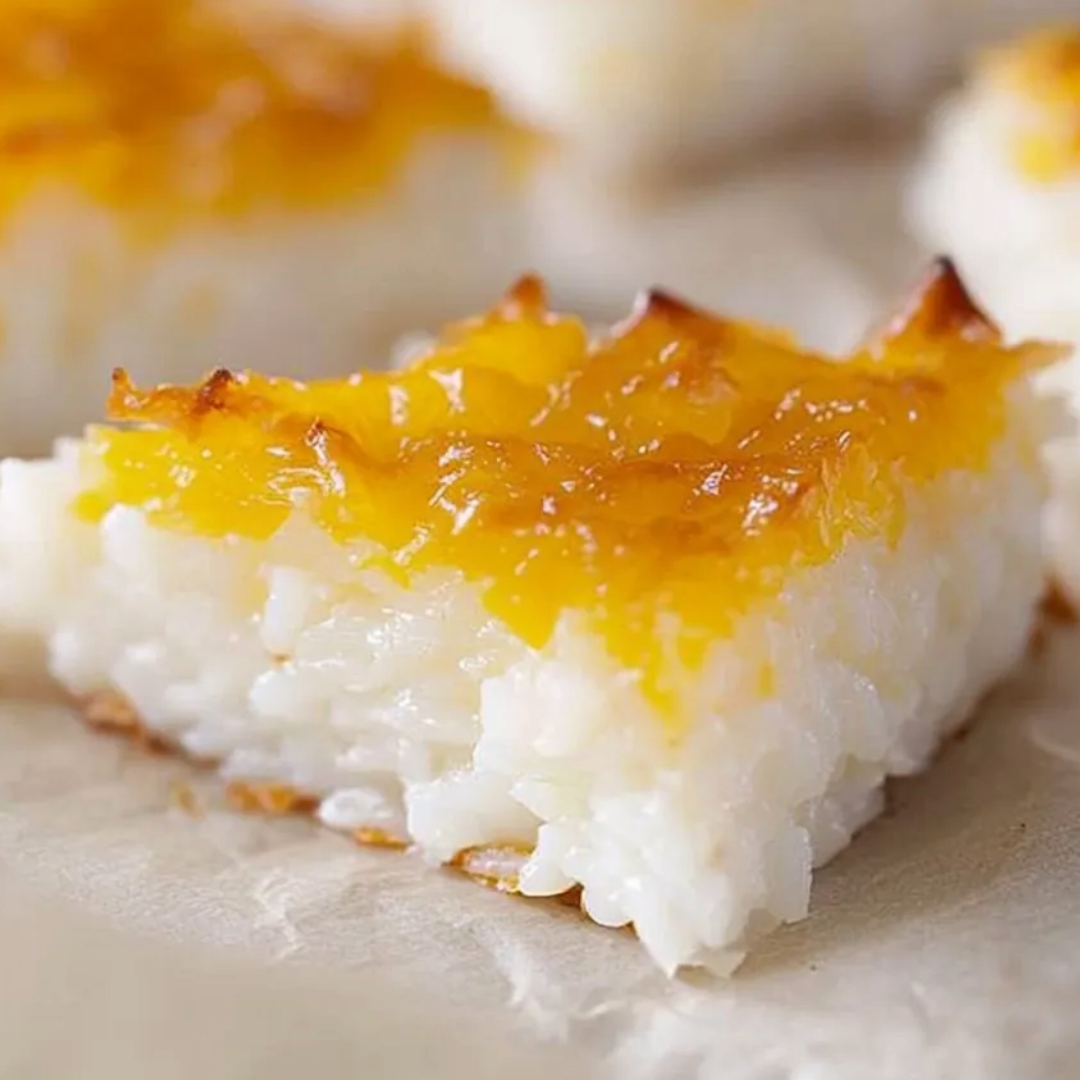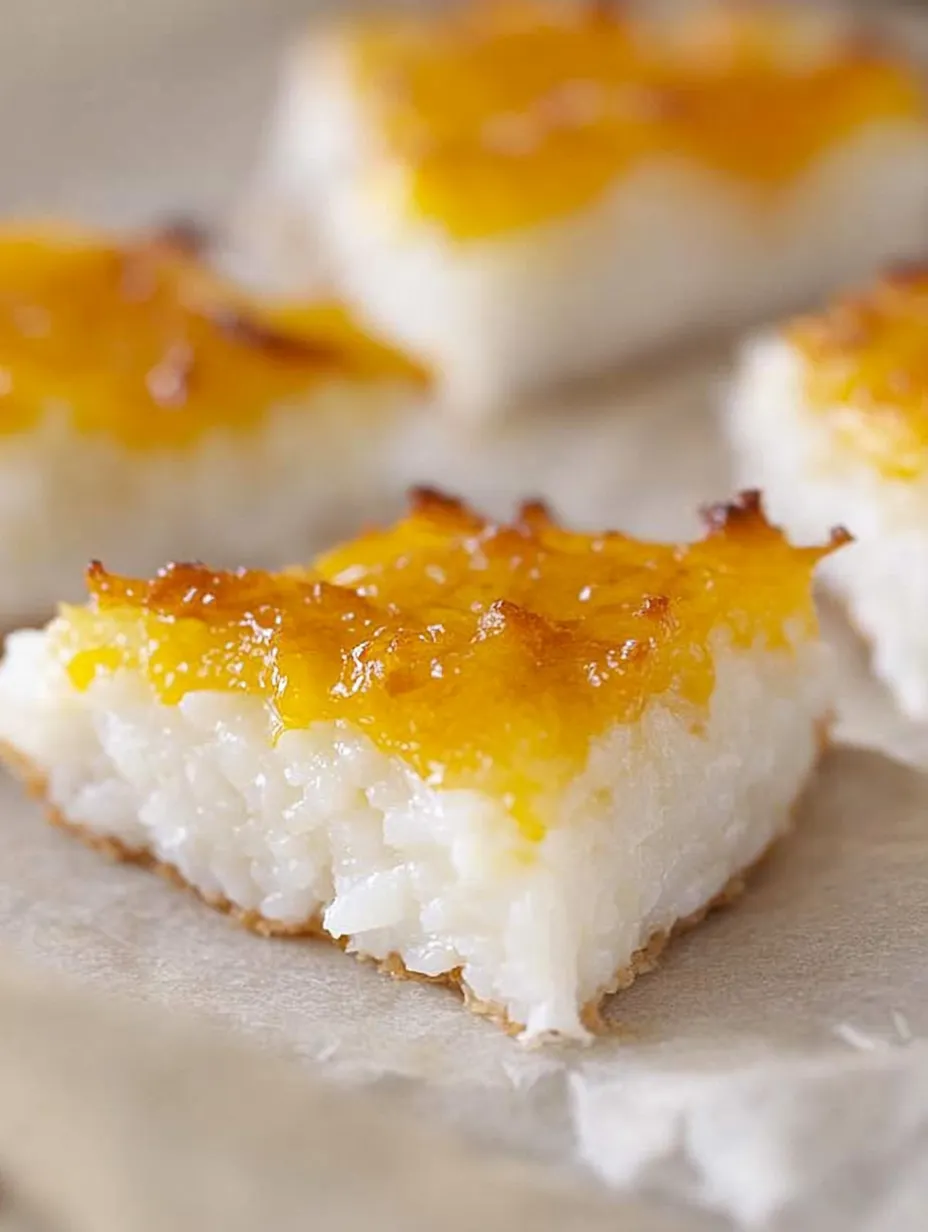 Pin it
Pin it
Indonesian sticky coconut cake (Wingko Babat) brings the tropical flavors of Java to your kitchen with its irresistibly chewy texture and rich coconut flavor. This gluten-free treat perfectly balances sweetness with the natural nuttiness of coconut, creating a dessert that's simultaneously fudgy, sticky, and utterly satisfying. Though adapted for ingredients readily available in American kitchens, this version captures the essence of the beloved Indonesian snack cake while maintaining the authentic chewy texture that makes this dessert so uniquely craveable for coconut enthusiasts.
I discovered this delightful treat while exploring Indonesian cuisine and was immediately captivated by its unique texture – similar to coconut macaroons but in cake form. When I first served these to friends at a potluck, the small squares disappeared within minutes, with everyone asking what this delicious coconut dessert was. It's now my go-to recipe whenever I want to introduce something beyond typical American desserts to friends and family.
Ingredients and Selection Tips
- Glutinous Rice Flour: Essential for achieving the authentic chewy texture; can use either Thai glutinous rice flour or Japanese Mochiko
- Shredded Coconut: Unsweetened works best to control the sweetness level; use finely shredded for the best texture
- Coconut Milk: Full-fat canned version provides the richest flavor; ensure it's well-mixed before using
- Granulated Sugar: Balances the richness of the coconut; adjust to your sweetness preference
- Eggs: Provides structure and a golden top when brushed on as a glaze
- Vanilla Extract: Enhances the coconut flavor for added depth
 Pin it
Pin it
Detailed Cooking Instructions
- Step 1:
- Begin by preheating your oven to 350°F (175°C) and preparing your baking dish. Line an 8×8-inch square baking pan with parchment paper, allowing the paper to extend over the sides for easy removal later. This preparation ensures your sticky cake won't adhere to the pan and can be lifted out cleanly.
- Step 2:
- Check your canned coconut milk before using it, as separation is common. Shake the can vigorously to recombine the coconut cream and water. If it remains separated after opening, pour it into a measuring cup and whisk until smooth, or warm it gently in the microwave or on the stovetop until fully incorporated and smooth.
- Step 3:
- In a large mixing bowl, combine 2 cups of glutinous rice flour and 2 cups of shredded coconut, stirring with a wooden spoon to distribute the coconut evenly throughout the flour. This dry mixture forms the foundation of your cake's texture, with the glutinous rice flour providing that characteristic chewiness.
- Step 4:
- Create a well in the center of your dry ingredients and add 1 cup of full-fat coconut milk, 1 cup of granulated sugar, 2 whole eggs (reserving 1 egg yolk for later), and 1 teaspoon of vanilla extract. The liquid ingredients will hydrate the rice flour and activate its sticky properties.
- Step 5:
- Mix all ingredients thoroughly until a thick, sticky batter forms with no dry spots remaining. You can do this by hand with a wooden spoon or with an electric mixer on medium speed for about 2 minutes. The batter will be quite thick and sticky – this is exactly what you want for the proper texture.
- Step 6:
- Transfer the batter to your prepared baking pan, using a wet spatula to spread it evenly to the corners. The moisture on the spatula prevents the sticky batter from adhering to it, making spreading much easier. Smooth the top as much as possible for even baking.
- Step 7:
- Bake in the preheated oven for approximately 25-30 minutes, until the edges begin to turn golden brown and the center is set but still slightly soft when gently pressed. The cake should not be completely firm when it comes out of the oven as it will continue to set as it cools.
- Step 8:
- While the cake is baking, prepare the egg wash by beating the reserved egg yolk with 1 teaspoon of water until smooth. This will create a golden, shiny finish on your cake that mimics the traditional charred exterior of authentic wingko babat.
- Step 9:
- Remove the cake from the oven and gently brush the top with the egg wash mixture, being careful not to press too hard and tear the delicate surface. Turn your oven to broil setting, then return the cake to the oven and broil for 1-2 minutes just until the top turns an attractive golden brown. Watch it carefully as it can burn quickly under the broiler.
- Step 10:
- Allow the cake to cool completely in the pan, then refrigerate for at least 2 hours or overnight. This cooling and setting period is crucial for developing the proper texture – the cake will become more chewy and fudgy as it cools. Once set, lift the cake out using the parchment paper overhang and cut into squares or triangles for serving.
I learned these tips through my own experimentation with this recipe. My first attempt was eaten too soon after baking and hadn't developed its characteristic chewiness. After refrigerating the leftovers overnight, I discovered the texture had transformed completely into the delightful sticky cake I was aiming for!
 Pin it
Pin it
The first time I brought these coconut cakes to a cultural food exchange, I worried they might be too unusual for American palates. To my delight, they were the first dessert to disappear! What I love most about sharing this recipe is watching people experience that moment of surprise when they bite into something completely different from what they expected. The dense, chewy texture combined with the rich coconut flavor creates an instant fan out of almost everyone who tries it. While this adaptation makes some concessions to ingredient availability, it captures the spirit of the original – a portable, satisfying treat that brings a taste of Indonesian cuisine to your kitchen with minimal effort and maximum flavor.
Frequently Asked Questions
- → What is glutinous rice flour and where can I find it?
- Glutinous rice flour (also called sweet rice flour) is made from ground sticky rice. Despite its name, it doesn't contain gluten. You can find it in Asian grocery stores, the international section of well-stocked supermarkets, or online. Common brands include Mochiko and Erawan.
- → Can I use regular rice flour instead of glutinous rice flour?
- Unfortunately, regular rice flour won't work as a substitute as it lacks the stickiness needed for this cake. Glutinous rice flour (sweet rice flour) is essential for the signature chewy, sticky texture that defines this traditional dessert.
- → Why does this cake need to rest overnight?
- The resting period allows the glutinous rice flour to fully set and develop its characteristic sticky, chewy texture. The cake will be too soft and won't hold its shape properly if cut before it has fully set. The waiting time is worth it for the perfect texture!
- → Can I use unsweetened shredded coconut instead of sweetened?
- Yes, you can use unsweetened shredded coconut, but you might want to increase the sugar by 2-3 tablespoons to compensate. The sweetened coconut contributes to both the flavor and texture of the traditional recipe.
- → How long will this cake stay fresh?
- When stored in an airtight container in the refrigerator, the cake will stay fresh for up to 5 days. You can also freeze individual pieces wrapped in plastic wrap and then aluminum foil for up to 3 months. Thaw in the refrigerator before serving.
